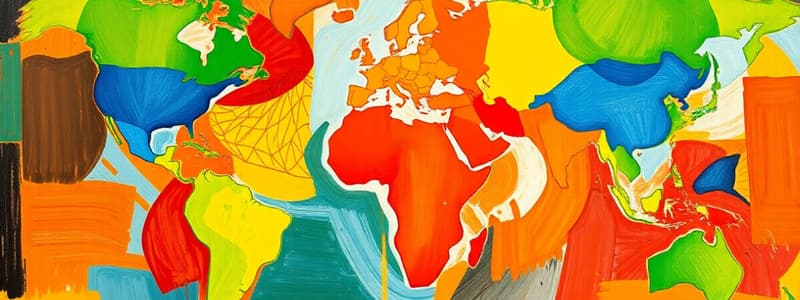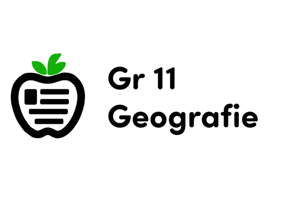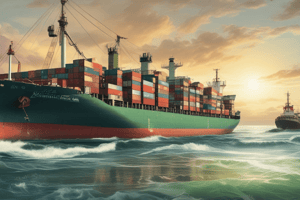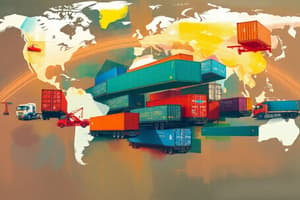Podcast
Questions and Answers
What is the fundamental characteristic of international trade?
What is the fundamental characteristic of international trade?
- The exchange of goods and services within a country.
- The production of goods and services in a single country.
- The establishment of sales facilities in a single country.
- The exchange of goods and services crossing national borders. (correct)
Which factor primarily drives the shift of production overseas, as described in the context?
Which factor primarily drives the shift of production overseas, as described in the context?
- Government regulations promoting domestic production.
- A decrease in demand for products.
- Similar production costs in all countries.
- Different production costs across countries. (correct)
In which phase of internationalization does a company establish its own sales and production facilities outside its home market?
In which phase of internationalization does a company establish its own sales and production facilities outside its home market?
- Phase 2: Production overseas.
- Phase 4: Company becomes multinational.
- Phase 1: Export and increase of sales.
- Phase 3: Establish own sales- and production facilities outside home market/overseas. (correct)
Which of the following industries is explicitly mentioned as having shifted production overseas?
Which of the following industries is explicitly mentioned as having shifted production overseas?
What does the final of the internationalization phases outlined by F. Root indicate?
What does the final of the internationalization phases outlined by F. Root indicate?
What is a primary factor influencing the design of supply chains?
What is a primary factor influencing the design of supply chains?
Which distribution strategy aims to maximize market penetration by utilizing as many outlets as possible?
Which distribution strategy aims to maximize market penetration by utilizing as many outlets as possible?
A company that limits its product availability to a few select outlets in order to maintain its brand image is using which distribution strategy?
A company that limits its product availability to a few select outlets in order to maintain its brand image is using which distribution strategy?
A manufacturer chooses to sell products through specific retailers in specific locations. This strategy is best described as...
A manufacturer chooses to sell products through specific retailers in specific locations. This strategy is best described as...
What is true of a company using an exclusive distribution strategy?
What is true of a company using an exclusive distribution strategy?
What is the main characteristic of a consignment agreement?
What is the main characteristic of a consignment agreement?
Which of the following is a primary driver for a company to pursue internationalization?
Which of the following is a primary driver for a company to pursue internationalization?
What is a disadvantage of free trade?
What is a disadvantage of free trade?
What primarily determines the value of import duty?
What primarily determines the value of import duty?
Which of the following is another term for import duty?
Which of the following is another term for import duty?
Which of the following is a function of the International Monetary Fund (IMF)?
Which of the following is a function of the International Monetary Fund (IMF)?
Which type of dumping is primarily aimed at eliminating competition?
Which type of dumping is primarily aimed at eliminating competition?
What does the Common Customs Tariff (CCT) ensure within the EU?
What does the Common Customs Tariff (CCT) ensure within the EU?
Which of the following arguments is NOT typically permitted as a justification for trade protectionism?
Which of the following arguments is NOT typically permitted as a justification for trade protectionism?
What is NOT considered a main type of duty or tax applied on imported goods?
What is NOT considered a main type of duty or tax applied on imported goods?
What are Incoterms primarily used for?
What are Incoterms primarily used for?
What is a ‘specific’ import duty?
What is a ‘specific’ import duty?
What is a tariff quota?
What is a tariff quota?
Which of these is considered a reactive motive for a company to leave their home market?
Which of these is considered a reactive motive for a company to leave their home market?
What does a structural export approach involve?
What does a structural export approach involve?
Which type of trade agreement involves multiple countries?
Which type of trade agreement involves multiple countries?
Which of these is an example of a non-tariff barrier?
Which of these is an example of a non-tariff barrier?
What characterizes managed trade?
What characterizes managed trade?
What is the primary aim of trade agreements like the one between the EU and Mercosur?
What is the primary aim of trade agreements like the one between the EU and Mercosur?
Which of the following is a major concern for French farmers regarding the EU-Mercosur trade agreement?
Which of the following is a major concern for French farmers regarding the EU-Mercosur trade agreement?
Why are some EU countries like the Netherlands and France critical of the EU-Mercosur trade agreement?
Why are some EU countries like the Netherlands and France critical of the EU-Mercosur trade agreement?
What does 'importing' primarily involve in international trade?
What does 'importing' primarily involve in international trade?
What potential benefit does the EU expect from the Mercosur trade agreement, beyond reducing trade barriers?
What potential benefit does the EU expect from the Mercosur trade agreement, beyond reducing trade barriers?
Which of the following best describes 'exporting' in the context of international trade?
Which of the following best describes 'exporting' in the context of international trade?
What is the estimated annual savings for European companies due to the EU-Mercosur trade agreement?
What is the estimated annual savings for European companies due to the EU-Mercosur trade agreement?
What does the term 'market needs' directly influence in international trade?
What does the term 'market needs' directly influence in international trade?
What is understood by 're-importation' in the context of Dutch trade?
What is understood by 're-importation' in the context of Dutch trade?
Which of the following best describes a 'transit' trade activity for the Netherlands?
Which of the following best describes a 'transit' trade activity for the Netherlands?
In the context of international trade, what is a 'deemed export'?
In the context of international trade, what is a 'deemed export'?
Which benefit is most directly associated with the export of goods and services?
Which benefit is most directly associated with the export of goods and services?
What is a key disadvantage for a company engaging in international import?
What is a key disadvantage for a company engaging in international import?
A buyer's bank promises to pay an exporter upon receiving specific documentation. What payment method does this describe?
A buyer's bank promises to pay an exporter upon receiving specific documentation. What payment method does this describe?
Which payment method requires the importer's bank to request permission to pay the seller before payment?
Which payment method requires the importer's bank to request permission to pay the seller before payment?
What is one way that exporting can help businesses?
What is one way that exporting can help businesses?
Flashcards
International Trade
International Trade
Exchange of goods and services across national borders.
Import & Export Management
Import & Export Management
Overseeing the flow of goods in and out of a country.
Internationalisation phases
Internationalisation phases
Stages a company goes through in becoming international.
Production overseas
Production overseas
Signup and view all the flashcards
Multinational Company
Multinational Company
Signup and view all the flashcards
Transport modalities
Transport modalities
Signup and view all the flashcards
Intensive Distribution
Intensive Distribution
Signup and view all the flashcards
Selective Distribution
Selective Distribution
Signup and view all the flashcards
Exclusive Distribution
Exclusive Distribution
Signup and view all the flashcards
Multimodal transportation
Multimodal transportation
Signup and view all the flashcards
Consignment
Consignment
Signup and view all the flashcards
Import Duty
Import Duty
Signup and view all the flashcards
Common Customs Tariff (CCT)
Common Customs Tariff (CCT)
Signup and view all the flashcards
VAT (Value Added Tax)
VAT (Value Added Tax)
Signup and view all the flashcards
Incoterms
Incoterms
Signup and view all the flashcards
Proactive Motives for Exporting
Proactive Motives for Exporting
Signup and view all the flashcards
Reactive Motives for Exporting
Reactive Motives for Exporting
Signup and view all the flashcards
Structural Export Approach
Structural Export Approach
Signup and view all the flashcards
EU-Mercosur Agreement
EU-Mercosur Agreement
Signup and view all the flashcards
Importing
Importing
Signup and view all the flashcards
Exporting
Exporting
Signup and view all the flashcards
Mutual Trade Agreement
Mutual Trade Agreement
Signup and view all the flashcards
Criticism of Trade Deals
Criticism of Trade Deals
Signup and view all the flashcards
Economic Impact of Agreements
Economic Impact of Agreements
Signup and view all the flashcards
Market Access
Market Access
Signup and view all the flashcards
Trade Collaboration
Trade Collaboration
Signup and view all the flashcards
Motives for internationalization
Motives for internationalization
Signup and view all the flashcards
Revenue growth reasons
Revenue growth reasons
Signup and view all the flashcards
Free trade advantages
Free trade advantages
Signup and view all the flashcards
Drawbacks of free trade
Drawbacks of free trade
Signup and view all the flashcards
GATT
GATT
Signup and view all the flashcards
Forms of dumping
Forms of dumping
Signup and view all the flashcards
Trade protectionism
Trade protectionism
Signup and view all the flashcards
Import duties
Import duties
Signup and view all the flashcards
Non-tariff barriers
Non-tariff barriers
Signup and view all the flashcards
Managed trade
Managed trade
Signup and view all the flashcards
Netherlands Exporting Economy
Netherlands Exporting Economy
Signup and view all the flashcards
Types of Exportation
Types of Exportation
Signup and view all the flashcards
Import Definition
Import Definition
Signup and view all the flashcards
Export Advantages
Export Advantages
Signup and view all the flashcards
Import Disadvantages
Import Disadvantages
Signup and view all the flashcards
Payment Methods in Trade
Payment Methods in Trade
Signup and view all the flashcards
Re-importation
Re-importation
Signup and view all the flashcards
Transit Shipping
Transit Shipping
Signup and view all the flashcards
Study Notes
Cross Border Supply Chains
- Cross-border supply chains involve international trade and import/export management.
- A "Monthly Review Report (MRR)" example is available for current end-to-end supply chains.
- The report includes product details, sourcing, production, and assembly locations.
- Transport modes, routes, and estimated transport costs are also included in the report for both local and cross-border transport.
- Hub locations and (crane) handling costs are also included per TEU and final product.
International Trade
- International trade is the exchange of goods and services across national borders.
- International trade developments include different production costs between countries, resulting in shifts of production to countries with lower costs (e.g., textile and ship building industries).
Internationalisation Phases (F. Root)
- Internationalisation starts with exporting and increasing sales.
- Then, production moves overseas.
- Establishing own sales and production facilities outside the home market follows.
- The company then becomes multinational.
- Lastly, international acquisitions or joint ventures occur.
Motives for Internationalisation (1)
- Companies may pursue internationalization to maintain continuity, spread risks, improve profits, and diversify markets.
- Expanding revenue may drive internationalization where the home market is too small or when the company has excess capacity.
- Finding high-quality staff overseas can also be a motivating factor.
Motives for Internationalization (2)
- Following customers internationally is an important driver for expanding businesses.
- Attractive market arrangements can also be a key motivation.
- Competition, where competitors are establishing a presence in the home market, may also drive businesses to seek international markets.
Trade Policies and the European Union
- Free trade offers efficient competition, technological innovation, and price stabilization.
- It avoids trade wars, and international rules are established.
- In contrast, drawbacks include the possibility of comparative costs and discrimination against developing countries.
International Trade Organizations
- The International Monetary Fund (IMF) fosters international financial stability.
- The World Trade Organization (WTO) resolves international trade disputes.
GATT Distinguishes Different Forms of Dumping
- Strategic dumping aims to eliminate competition.
- Social dumping involves setting wages and benefits below the actual value.
- Subsidized dumping utilizes government subsidies for export.
- Price discrimination involves charging different prices across different markets.
Trade Protectionism
- Not permitted protectionist arguments include those based on the labor standards or balance of payments.
- Permitted arguments include infant-industry protection for emerging industries and anti-dumping measures against unfair pricing practices.
- Check the given web address for additional information.
Forms of Protectionism– Import Duties
- Specific duties are fixed amounts per unit volume.
- Ad valorem duties are based on the value of the product.
- Sliding/variable duties adjust tariffs based on the product price.
- Prohibitive tariffs are so high that imports are essentially impossible.
- Implicit tariffs use varying tariff rates for raw materials versus finished products.
Forms of Protectionism– Quotas
- Quantity quotas restrict the total quantity of imported goods.
- Tariff quotas levy import duties once the quota limit is reached.
- Quotas can be bilateral (between two countries), multilateral (between multiple countries), or global (for everyone).
Forms of Protectionism– Trade Agreements
- Bilateral or multilateral trade agreements may involve developing countries or nations that aren't members of the WTO.
Forms of Protectionism– Non-tariff Barriers
- Rules regarding axle weights for trucks, health and safety regulations, and customs formalities are non-tariff barriers.
- Administrative procedures, like test specifications, are also considered non-tariff barriers to trade.
Forms of Protectionism – Managed Trade
- Government trade relations still exist in countries like China and Cuba.
- Managed trade is influenced by factors besides market forces, such as government intervention, particularly in strategic goods like aircraft.
- (Example: Airbus vs Boeing in Saudi Arabia.)
New Forms of Protectionism
- Agreements to divide markets and offer subsidies by sector or specific countries exist.
- The OECD may reorganize industry or agriculture.
- Trade agreements may use direct subsidies (credit arrangements, financial support) as protectionist practices.
Regional Formation of 'Blocks'
- Regional trade agreements often involve the removal of internal tariffs and the common external tariff.
- These agreements may also involve harmonization of economic policies.
- Links between trade blocs and various political integrations are discussed.
Import and Export Management
- Import and export involve the exchange of capital, goods, and services across national borders.
- Exporting involves selling products and services produced domestically.
- Importing involves buying foreign products and services to bring them into the domestic market.
- The Netherlands is involved in import and export trade, often acting as a distribution hub.
Different Forms of Import and Export
- Exportation covers exporting domestically produced goods.
- Re-importation entails exporting previously imported goods.
- Transit imports are when items pass through a country without being added value.
- Imports introduce foreign goods into the domestic market.
Types of Import and Export
- B2B and B2C goods and services are examples of imports.
- Physical exports and deemed exports, relating to controlled technology, are described.
- There could be other forms of import and export not covered (direct, indirect, one-time, recurring, etc.).
Import
- Advantages of importing include international sourcing for cheaper goods, benefiting from the global economy, and expanding sales volumes.
- Disadvantages include increased risk, vulnerability to exchange rate fluctuations, and higher communication costs.
Export
- Advantages of exporting include increased sales and potential, higher profits, spreading risks, potential for new productivity, and accessing new technologies.
- Disadvantages include additional logistical costs and challenges.
Payment Methods
- Payment methods in international trade include cash in advance, letters of credit, documentary collections, open account, and consignment.
- Each method has differing levels of security and risk exposure.
Import and Export Duties (Import Duties only for clarity)
- Import duties are taxes imposed on imported products.
- A good’s value typically determines the duty amount.
- When importing into the Netherlands from non-EU countries, import duties, VAT, and other levies may apply.
Import and Export Duties (2)
- All EU member states use a common customs tariff (CCT).
- Duties and taxes differ depending on the product and origin.
- Taxes and duties are added to the base price of products in the importing country.
Incoterms
- Incoterms are internationally recognized trade terms (published by ICC).
- Incoterms define the responsibilities of buyer and seller for goods exchange in international trade.
- Incoterms details are contained through 3 letter trade terms.
Motives for Leaving Home Market
- Proactive motives include seeking tax benefits and identifying opportunities in foreign markets.
- Reactive motives for leaving home markets may include the need to address competition and high production volumes.
Structural Import/Export Approach
- More and more companies are focusing on overseas activities that necessitate a structural export method.
- Setting up an export plan or structure provides insights and awareness of possibilities and market objectives and provides opportunities available on a global scale.
Transport Modalities
- Each transport modality has advantages and disadvantages.
- Combinations of transport modalities (intermodal and multimodal) are frequently used and have their own advantages and challenges.
- Companies use relevant criteria concerning transport modalities (including sustainability).
Channels of Distribution
- Distribution strategies include zero channels, single-level channels, two-level channels, and three-level channels.
- Logistics channels cover all possible distribution routes for goods from manufacturers to consumers.
Distribution Strategies
- Distribution strategies include intensive (numerous outlets for maximum market penetration), selective (limited outlets based on store suitability), and exclusive distribution (minimal outlets aiming to safeguard a brand's differentiation).
Distribution Profiles
- Distribution profiles include distributors, wholesalers, retailers, and agents.
- Each profile has a distinct function in the distribution process (sales, warehousing, retail, and representation).
Perlmutter Theory
- The EPRG model suggests four different corporate cultures toward internationalization: ethnocentric, polycentric, regionally centered, and geocentric.
- Each type of company culture has varying approaches to international markets and trade.
Ethnocentric Company
- Ethnocentric companies focus on activities within the home nations.
- Trade within the home country is prioritized and considered more important than foreign markets.
- Market penetration relies on chance rather than careful planning.
Polycentric Company
- Polycentric companies acknowledge cultural differences.
- They adopt different business approaches in different markets and countries.
- They establish independent companies in other territories rather than relying on a single-head office or company culture.
Regional Company
- Regional companies adapt their strategy according to distinctions between their various market regions (e.g., North America, EU, and Asia Pacific).
- The same approach and experience are reflected in the chosen regions and countries.
Geocentric Company
- Geocentric companies use similarities and differences in markets in their approach.
- They establish a worldwide strategy and recognize that country relations are irrelevant to the structure.
- This corporate structure is often considered ideal for management.
Next Steps
- There is a workshop on International Trade – Import & Export, which follows an update of the previously discussed MRR and the subsequent Portfolio additions.
Studying That Suits You
Use AI to generate personalized quizzes and flashcards to suit your learning preferences.



